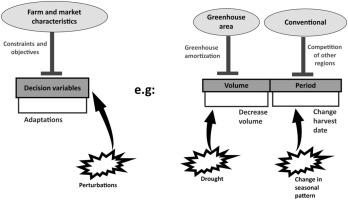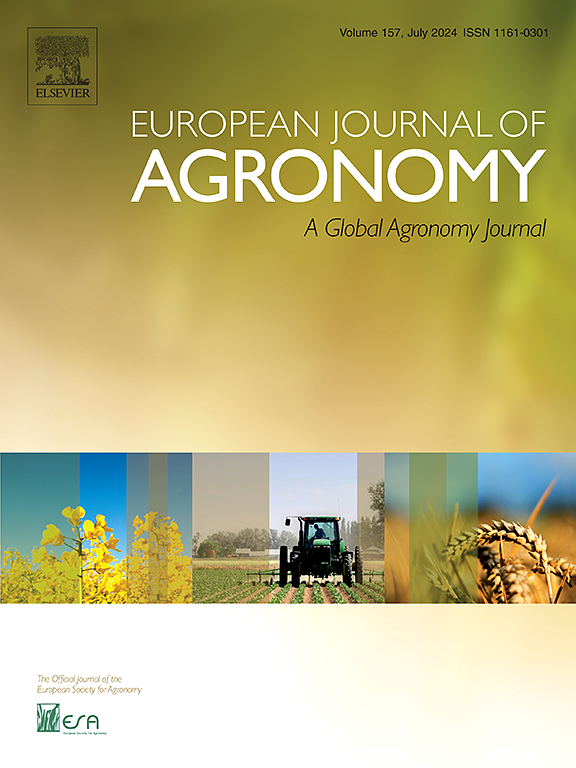蔬菜长供应链中农民生产计划适应性的多样性
IF 5.5
1区 农林科学
Q1 AGRONOMY
引用次数: 0
摘要
长供应链蔬菜种植者与中间商协调生产计划,以优化易腐产品的分配。这样做,农民必须同时考虑他们自己和中间商的约束和目标。随着扰动变得更加频繁和强烈,农民必须适应。蔬菜种植者适应的多样性还没有根据农场和市场特征进行分析,并与决策联系起来。我们的目标是i)根据农场和市场特征确定规划决策的差异,ii)通过这些决策差异解释适应的多样性。我们对法国鲁西永平原上新鲜蔬菜长供应链的18位农民和6位中间商进行了半结构化采访。根据农户和市场特点对访谈内容进行分析比较。我们发现生产计划对应于六个决策变量:出口、品种、数量和采收期的调度;并实时管理网点和收获。这些变量受到与农民(例如,温室摊销)或中间商(例如,来自其他地区的竞争)有关的9个制约因素和目标的影响。根据农场(如温室面积)和市场(如传统)的六个特征,它们的应用方式不同。受访的农民认为有六种扰动,最常提到的是有机部门危机、季节模式的变化和干旱。他们通过实施适应性措施(例如,改变种植日期)来应对这些干扰。我们揭示了农民规划适应的多样性,以及这些适应与农民决策的一致性。我们说明协调规划的重要性,既是一个杠杆和障碍,蔬菜种植者的适应。本文章由计算机程序翻译,如有差异,请以英文原文为准。

Diversity of production planning adaptations of farmers in vegetable long supply chains
Long supply chains vegetable growers coordinate production planning with middlemen to optimize distribution of their perishable products. Doing so, farmers have to consider both their own and middlemen’s constraints and objectives. As perturbations become more frequent and intense, farmers have to adapt. Diversity of vegetable growers’ adaptations has not been analyzed according to farm and market characteristics and linked with decision-making. We aim to i) identify differences in planning decision-making according to farm and market characteristics, and ii) explain diversity of adaptations by these differences in decision-making. We conducted semi-structured interviews with 18 farmers and six middlemen involved in fresh vegetable long supply chains on the Roussillon plain, France. Interview content was analyzed and compared according to farm and market characteristics. We show that production planning corresponded to six decision variables: scheduling for outlets, species, volume, and harvest period; and real-time management of outlets and harvest. These variables were influenced by nine constraints and objectives associated with farmers (e.g., greenhouse amortization) or middlemen (e.g., competition from other regions). They applied differently according to six characteristics of farms (e.g., greenhouse area) and market (e.g., conventional). Interviewed farmers perceived six perturbations, most often mentioned being organic sector crisis, changes in seasonal patterns, and drought. They faced these perturbations by implementing 11 adaptations (e.g., change planting date). We shed light on the diversity of planning adaptations among farmers and the consistency of those adaptations with farmers’ decision-making. We illustrate the importance of coordinated planning as both a lever and an obstacle for vegetable growers’ adaptation.
求助全文
通过发布文献求助,成功后即可免费获取论文全文。
去求助
来源期刊

European Journal of Agronomy
农林科学-农艺学
CiteScore
8.30
自引率
7.70%
发文量
187
审稿时长
4.5 months
期刊介绍:
The European Journal of Agronomy, the official journal of the European Society for Agronomy, publishes original research papers reporting experimental and theoretical contributions to field-based agronomy and crop science. The journal will consider research at the field level for agricultural, horticultural and tree crops, that uses comprehensive and explanatory approaches. The EJA covers the following topics:
crop physiology
crop production and management including irrigation, fertilization and soil management
agroclimatology and modelling
plant-soil relationships
crop quality and post-harvest physiology
farming and cropping systems
agroecosystems and the environment
crop-weed interactions and management
organic farming
horticultural crops
papers from the European Society for Agronomy bi-annual meetings
In determining the suitability of submitted articles for publication, particular scrutiny is placed on the degree of novelty and significance of the research and the extent to which it adds to existing knowledge in agronomy.
 求助内容:
求助内容: 应助结果提醒方式:
应助结果提醒方式:


